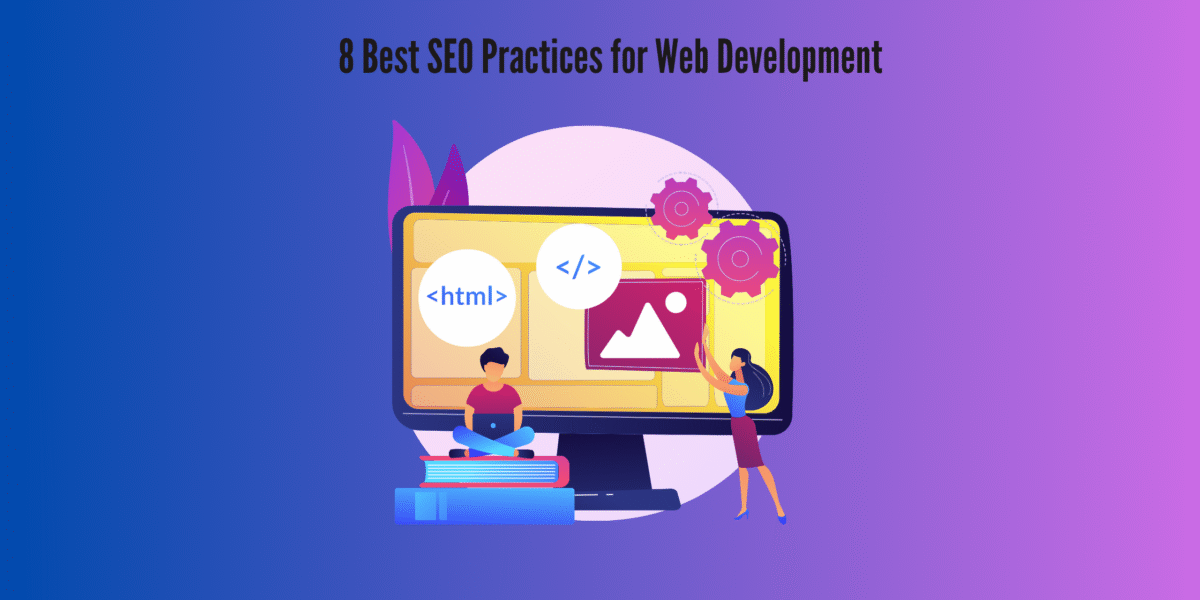Okay, I get it. As a web developer, you may feel out of place when it comes to SEO. But guess what? It’s not as confusing as it sounds. And as a fellow tech lover (I was an IT student back in the day and still learning more about the tech coz it’s always changing haha!), I know you’re more than capable of understanding the basics and getting your website the attention it deserves from search engines. It is so much simpler than you might think.
Now let’s tackle the best SEO practices for web development. Let’s get started!
The Significance of Clean Coding
Clean coding offers far more than just a nice appearance; it’s the bedrock of exceptional user experience (UX) and strong SEO performance. Organized and streamlined code directly benefits your website in several crucial ways:
- Think of complex, disorganized code like a poorly lit, cluttered room. Users, much like website visitors, want everything to be clear and streamlined. Clean code ensures your website runs smoothly, offering a frictionless and welcoming experience that compels people to stay longer.
- Search engines analyze and rank websites based in part on the quality of their code. Think of clean code as giving Google a clear map of your website – they can then index and understand the content with ease, potentially boosting your ranking.
- Clean coding translates to better website functionality. Think of it as the “invisible” force that ensures your site runs without errors or surprises. A solid codebase minimizes crashes and potential security issues, directly improving reliability.
Here are some specific examples of why clean code matters:
Semantic HTML: Properly using elements like <header>, <section>, <article> gives your code greater clarity and helps search engines understand its structure.
Meaningful CSS Class Names: Instead of generic names like .box1, write .product-description – easier for both you and search engines!
Comments: Explain what different sections of your code do, aiding future development and troubleshooting.
Remember: Clean, well-organized code benefits you as the developer, the website visitors, and those search engines helping people find your site. It’s a true win-win-win!
Optimizing Website Load Times
A fast website is critical for keeping visitors happy and search engines satisfied. Here’s a checklist to tackle slow load times:
Optimize Images:
Compress: Reduce file sizes with tools like TinyPNG or ImageOptim without sacrificing noticeable quality.
Format: Choose appropriate formats (JPEG for photos, PNG for graphics, WebP whenever possible).
Lazy Loading: Defer loading of images below the fold until the user scrolls.
Minimize Redirects:
301 vs. 302: Use 301s for permanent page moves, 302s for temporary. Minimize redirects as each causes extra load time.
Compress Files:
Gzip: Employ Gzip compression to shrink files (HTML, CSS, JavaScript) before sending them to the browser.
Enable Browser Caching:
Leverage Caching: Instruct browsers to save static files (e.g., images, stylesheets) for repeat visitors, so they don’t have to download everything every time.
Streamline Code:
Minify: Remove unnecessary characters, spaces, and comments from your HTML, CSS, and JavaScript files.
Additional Tips
Choose a Fast Hosting Provider: A reliable web host has a huge impact on site speed.
Utilize a Content Delivery Network (CDN): CDNs spread copies of your site across global servers, making it faster for visitors from different locations.
Remember: Even small improvements add up! Test your website’s speed regularly with tools like Google PageSpeed Insights for further optimization advice.
Correct Use of Redirects
Redirects are essential for a smooth website experience and to preserve your SEO authority during changes. Here’s a breakdown of the most common types and when to use them:
Types of Redirects
301 Redirects (Permanent):
Signal: The page has moved permanently to a new location.
Best for:
- Site migrations or restructurings
- Merging content
- Fixing outdated URLs
302 Redirects (Temporary):
Signal: The page is unavailable for a short period.
Best for:
- Website maintenance
- A/B testing variations
- Seasonal promotions
Meta Refresh Redirects:
Caution: Generally not recommended, as they can be confusing for users and search engines.
Situations for Use (if unavoidable): Very short delays on pages, but be sure to inform users of the redirect
Important Notes:
- Search Engine Indexing: 301 redirects pass most of the “link juice” (ranking power) to the new page, while 302s do not.
- User Experience: Avoid redirect chains (multiple redirects in a row), as they slow down the loading process.
Importance of Sitemaps
Sitemaps give search engines a clear blueprint of your website, boosting crawling efficiency and ensuring all your important content gets indexed. Here’s why they matter:
Improved Crawling:
- Large Sites: Especially helpful for complex websites with many pages.
- New Pages: Sitemaps help search engines discover new content quickly.
Enhanced Visibility:
Content Prioritization: Highlight your most important pages to search engines.
Easy Creation & Submission:
- XML Sitemaps: Use online tools or your website platform to generate them. You can try to use any SEO plugin such as Rank Math’s WordPress SEO plugin.
- Google Search Console: Submit your sitemap for proactive indexing.
Additional Tips
- Ensure your sitemap always reflects your current website structure.
- Support sitemaps with good internal linking practices to maximize crawlability.
Ensuring Mobile-Friendly Design
Mobile-friendliness isn’t just nice to have – it’s essential for both user experience and SEO success. Here’s a checklist to prioritize:
Design Basics
- Responsive Design: Your website must adapt seamlessly to different screen sizes (desktops, tablets, phones). Use CSS media queries to achieve this.
- Readability: Avoid tiny fonts, horizontal scrolling, and cramped layouts.
- Tappable Elements: Buttons and links should be large enough for fingers, not just mouse cursors.
Content is Key
- Easy to Scan: Short paragraphs and bullet points help on small screens.
- Test It Yourself: Regularly view your site on your own phone – is it a positive experience?
Tools to Help
- Google’s Mobile-Friendly Test: Get an official verdict and improvement suggestions: https://search.google.com/test/mobile-friendly
Remember: A great mobile experience translates to happier users and better search engine rankings!
Understanding Robots.txt Files
The robots.txt file, tucked away in your site’s root, is a powerful tool for managing search engine interactions. Understand its syntax and potential pitfalls, and you’ll ensure bots are indexing the right parts of your carefully crafted website.
Key Points for Web Devs
- Location Matters: robots.txt must be in the root directory (e.g., [invalid URL removed]) for bots to find it.
- User-Agents: Target specific bots (e.g., “User-agent: Googlebot”) or all bots (“User-agent: *”).
- Allow & Disallow: These directives are your bread and butter for controlling what gets crawled. Be precise with paths!
- Don’t Block CSS/JS: If search engines can’t access these, they can’t understand your site’s content and layout.
Strategic Uses
- Dev Environments: Keep staging areas private during development.
- Cleaning House: Prevent indexing of thin content, URL parameters, or duplicate pages.
- Resource Management: On massive sites, prioritize crawling of top-tier pages.
Pro Tips
- Test & Validate: Use Google Search Console tools and other validators to catch errors before they cause indexing issues.
- Less is More: A focused robots.txt is easier to maintain and less prone to mistakes.
My favorite tool to test out robots.txt is Screaming Frog. To learn more about how to test robots.txt in Screaming frog, they have a very detailed guide on how to test a robots.txt using the SEO Spider.
Remember, incorrect robots.txt directives can seriously hinder your SEO. Tread carefully and test meticulously!
Implementing Structured Data
Think of structured data as adding a superpower to your website’s code. It helps search engines understand your content more, boosting your chances of appearing in the right search results.
Why Web Devs Should Care
- Structured data uses standardized formats (like JSON-LD, Microdata) to precisely label your content elements. It’s like providing a dictionary for search engines.
- Rich Results Eligibility: Detailed product info, event listings, reviews… have those eye-catching search result features? Structured data is often required.
- It helps search engines grasp the context of your pages – are you a local business, a recipe site, an article aggregator? This informs accurate results placement.
- While not a direct ranking factor, well-structured data often goes hand in hand with organized code, which benefits overall crawlability.
Getting Started
- Schema.org Vocabulary: Check out the https://schema.org/ library – there’s a markup type for most common content elements.
- SchemaApp also offers a free course for you to learn about Schema Markup.
Google’s Tools:
- Structured Data Markup Helper: (https://www.google.com/webmasters/markup-helper/u/0/) to generate code.
- Rich Results Test: (https://search.google.com/test/rich-results) to validate your implementation.
The Role of Image Optimization
Images are crucial for engagement, but they can also be performance killers. Image optimization is essential for both user experience and SEO. Here’s what you need to know:
Key Optimization Techniques
- Compression: Reduce image file size without noticeable quality loss. Tools to consider:
- TinyPNG (https://tinypng.com/)
- ImageOptim (https://imageoptim.com)
- Your CMS likely offers built-in options too!
- Format Choice: Choose wisely:
- JPEG for photos, good compression
- PNG for graphics, supports transparency
- WebP for modern browsers, superior compression
- Responsive Images: Use srcset and sizes attributes to serve different image sizes based on the user’s device.
- Lazy Loading: Defer the loading of images below the fold until they’re needed. Native browser lazy loading is an option now!
SEO-Friendly Image Practices
- Descriptive File Names: Instead of “img0023.jpg” use “red-sports-car.jpg”
- Informative Alt Text: Describe the image for visually impaired users and search engines. Use relevant keywords naturally.
Why Optimization Matters
- Faster Page Loads: Crucial for happy users and search engine rankings.
- Improved Accessibility: Benefits everyone, particularly users with assistive technologies.
- Image Search Visibility: Optimized images can rank well, driving additional traffic.
Told you, it’s not that complicated!
There you have it. See? It’s not that complicated. Read more on my blogs to learn more about SEO.

